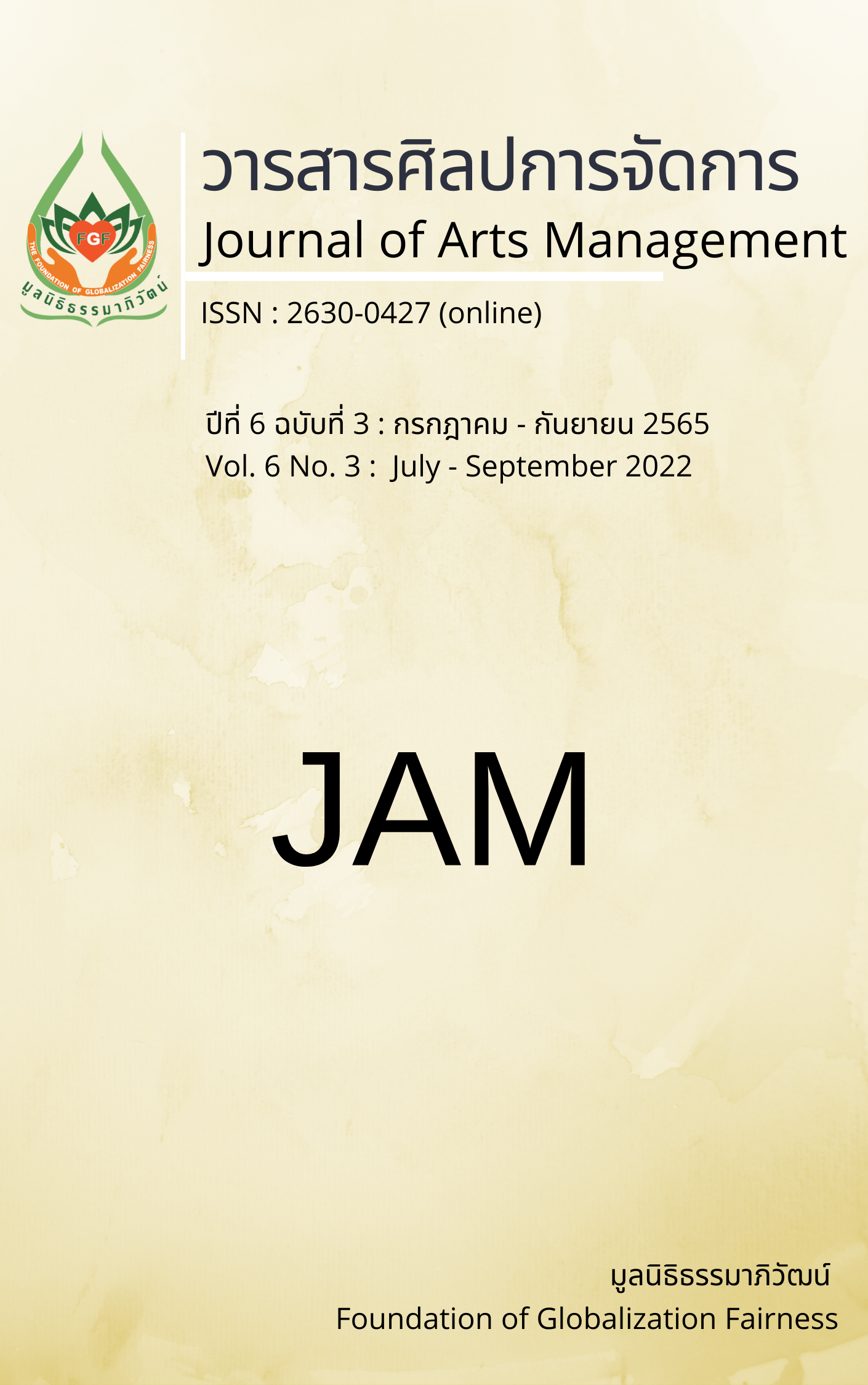Causal Factors Influencing Purchase Intention of Cosmetic on Facebook Pages La’ Peak of Consumers in Thailand
Main Article Content
Abstract
This research article aimed to 1) develop and validate the coherence of the causal relationship model of cosmetic purchase intention on the LA' PEAK Facebook page among Thai consumers and 2) study the causal factors influencing the purchase intention of cosmetics on the LA' PEAK Facebook page. The research model was quantitative research. Data Collection Tools, including online questionnaires. The sample group consisted of people who have bought cosmetics on the LA' PEAK Facebook page and live in Thailand; 370 people. The statistics used for data analysis were frequency, percentage, and structural equation model.
The results showed that they had developed a causal relationship model consisting of four aspects: 1) cause-related marketing and campaigns; 2) brand awareness; 3) image; and 4) purchase intentions. This was consistent with the empirical data as well. The statistics showed that the Chi-square statistics goodness of fit test (χ2) = 233.33, degrees of freedom (df) = 128, CMIN/df = 1.82, GFI = 0.94, AGFI = 0.90, SRMR = 0.03, RMSEA = 0.05. The final predictive coefficient was 0.99. It showed that the variables in the model could explain 99 percent of the variability of cosmetic purchase intentions on the LA' PEAK Facebook page of Thai consumers: cause-related marketing and campaigns, brand awareness, and image. It has a direct influence and indirect effect on the purchase intention. The Lapa corporation can use the research results to plan and create a strategy. It is suitable for customers in order to achieve their next purchase intention.
Article Details

This work is licensed under a Creative Commons Attribution-NonCommercial-NoDerivatives 4.0 International License.
Views and opinions appearing in articles in the Journal of Arts of Management It is the responsibility of the author of the article. and does not constitute the view and responsibility of the editorial team I agree that the article is copyright of the Arts and Management Journal.
References
Aaker, D. A. (1991). Managing brand equity: Capitalizing on the value of a brand name. Free Press.
Chelliah, S., Kwon, C. K., Annamalah, S., & Munusamy, J. (2013). Does marketing mix still relevant? A study on herbal coffee in Malaysia. International Journal of Management and Innovation, 5(1), 31-45.
Choonhavejsakul, A., Laksitamas, P., & Horungrueng, C. (2019). The Effects of creative marketing and Thai tourism content advertising on the purchase intentions of Chinese, Japanese, South Korean Generation-Y tourists. Journal of Silpakorn University, 39(1), 78-79.
Detnakarin, S., & Yincharoen, T. (2021). The relationship of the marketing mix on purchase intention of at-home coffee consumption. Journal of Marketing and Management, 8(2), 156-158.
Electronic Business Development Office. (2019). Looking at the behavior of netizens in 2019, using social media the most. www.etda.or.th
Electronic Transactions Development Agency. (2021). A channel that likes people who buy and sell online. Ministry of Digital ETDA. www.etda.or.th
Hair, J.F., Black, W.C., Babin, B.J., & Anderson, R.E. (2010). Multivariate data analysis (7th ed.). Pearson.
Hoelter, J.W. (1983). The analysis of covariance structures: Goodness-of-fit indices. Sociological Methods and Research, 11(3), 325–344.
Kananurak, N. (2018). Brand equity affecting purchase intention of consumers in Bangkok to sport shoe brand. Journal of Modern Management, 16(1,) 209-210.
Kline, R.B. (2011). Principles and practice of structural equation modeling (3rd ed.). The Guilford.
Lekcharoen, S., & Kulkanok, K. (2021). The confirmatory factor analysis of factors influencing to buying behaviors Keracosmetic cosmetic in body lotion on Instagram of consumers in Bangkok and its Vicinity. Journal of Multidisciplinary in Humanities and Social Sciences, 4(2), 447-450.
Prongchit, L. (2021, November 16). The launch event of Lapa Corporation, the manufacturer and distributor of La Peak cosmetics brand. https://www.facebook.com/lapeakphnompenh/posts/1802713673167731/
Rangsungnoen, K. (2011). Actor analysis by SPSS and AMOS for Research. SE-EDUCATION.
Sangwan, J., & Boonthawan, W. (2018). Effect of integrated marketing communication and brand value perception toward purchase intention of local coffee brand as the perspective of customers in Amphur Muang Lampang, Lampang Province. International Journal of Management and Applied Science, 4(1), 53-56.
Schumacker, R. E., & Lomax, R. G. (2010). A beginner's guide to structural equation modeling (3rd ed.). Lawrence Erlbaum Associates.
Sheriff, N. M., Ismail, H., Abu Bakar, Z. I., & Damain, D. (2016). Coffee marketing: What matters to coffee drinkers?. Journal Intelek, 10(2), 15-28.
Siri, R. (2018). The Segmentation of coffee drinkers by using lifestyle and the perceived value of coffee shop: A case study of international tourists in Chiang Mai Province. FEU Academic Review,12(2), 199-216.
Smith, R. (2013). Education policy [electronic resource]: Philosophical critique. Wiley.
Sualuang, S., & Udomthanavong, S., (2020). Celebrity influencer and tie-in perception affects the brand awareness on purchase intension of motorcycle consumer via series online in Bangkok. Sripatum University.
Sutthasaen, S. & Supornpraditchai, T. (2017). The influence of alcohol marketing communications on consumer purchase intention. Journal of Business Administration, 6(1), 158-160.
Thaotrakool, N. (2018). The influence of brand image and value toward organizational performance in budget hotel in Mueang District, Chiang Mai. MUT Journal of Business Administration, 15(2), 5-13.
Thongrawd, C., & Rittboonchai, W. (2018). Factor affecting coffee consumer’s behavior: A case study of consumption in Metropolitan Bangkok. Journal of Thai Interdisciplinary Research, 13(5), 48-53.
Wiratchai, N. (1999). Lisrail model: Analytical statistics for research (3rd ed). Chulalongkorn University.
Yothinbunnark, P., & Pimchangthong, D. (2016). The influence of store image on customer perceptions: A case study of Mc. Jeans store in Bangkok. Valaya Alongkorn Review (Humanities and Social Sciences), 6(1), 65-67.


